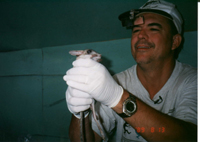|
The project started in 1999 as
a collaboration among the National University of Mongolia,
the Museum of Southwestern Biology of the University of New Mexico, the H.W. Manter Laboratory of Parasitology of the
University of Nebraska-Lincoln, and Hokkaido University under the auspices
of the International Long–Term Ecological Research
(ILTER) program of the National Science Foundation.
The overall goal of this collaboration is to study the systematics,
biogeography,
historical ecology, natural history, and ecology of small mammals and their parasites.
In other words: what are they, who are they related to, where do they come from, what do they do, and how do they interact with each other and their environment.
As part of our current project to survey the Gobi Gurvan
Saikhan National Park we have expanded our collaboration to
include research into the birds, reptiles, and amphibians of
this region.
This type of research provides baseline data
of what lives where and how they exist which is essential for ecological
researchers, conservation managers, and political decision makers. Information from small mammals and their parasites, when coupled with historical,
environmental, and hopefully long term monitoring and ecological data, serve as indicators of climate change, environmental impacts
and biodiversity. Knowing what parasites are present in the region also allows one to assess potential health threats
to both the wildlife and human inhabitants of the area. Finally, since Mongolia sits at the crossroads of habitats across northern
Asia, this provide important comparative resources for the study of mammals and their parasites across the continent.
|


|







